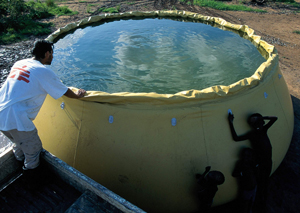WATER TANK onion, 30m³ + 2x3" gate valve + 4 half-coupl+lock
Valid Article
WATER TANK onion, 30m³ + 2x3" gate valve + 4 half-coupl+lock
Definition
30 m3 water tank, with two 3" or DN75 gate valve. Each valve has half symmetrical couplings on both extremity. Part of the (KWATKTAN30O KIT, WATER TANK, 30 m³, onion-shaped, storage/treatment)
Flexible, self-supporting tank intended for the storage, chlorination and distribution of drinking water, as well as for the treatment of turbid water by (assisted) sedimentation.
Specifications
Water tank
- Flexible "onion shaped" tank
- Capacity: 30 000 litres
- Dimensions (may vary depending on the supplier):
- lower Ø = ± 6.40 m
- height = 1.50 m
- Liner: resistant PVC, anti UV, yellow or blue colour
- Top sheet with float and elastic straps
- MSF logo + volume indication
- Supplied with groundsheet and repair kit
Flocculation module for assisted sedimentation
- Suction hose with a strainer and a float to be connected to the tank's inner 3" outlet coupling to evacuate the treated water
- 3” elbow to be connected to the inner 3” inlet coupling to create a circular water movement during filling, speeding up the flocculation
- T with valve to be connected to the outer inlet coupling to drain the sludge once in a while
Instructions for use
This tank is not suitable for transport.
Inflate the upper ring for the onion to be self-supporting (no need for poles).
For water storage
The top sheet prevents evaporation and protects water against pollution.
Choose a site for the installation
- A water tank must be installed on an even, stable and horizontal platform, accessible under all circumstances and at all times to be able to fill it
- A filled tank is heavy and needs to be installed properly at a safe location where it can't cause accidents (e.g. filled tank rolling down a slope, collapse of a building under the weight of a filled tank installed against a wall or on top of the roof…)
- The choice of the site should always be discussed with the different stakeholders
Gravity water distribution requires the "MODULE, WATER DISTRIBUTION" (see related articles below). The water tank should be located at least 1.2 meter above the level of the tap stand located close by (higher if possible) to obtain a correct flow. It is advised not to connect more than 4 tap stands to one tank, except when part of a distribution network with very regular water supply to the reservoir.
Water distribution can also be done without gravity, by means of a hand/motor pump (contact your technical department for further information).
When the water tank is installed on an earth embankment, protect its slopes from erosion with grass, stones or plastic.
Always put the water tank on its groundsheet to protect it against punctures.
Protect the tank from direct exposure to the sun by means of a roof or a shadow net.
Fence the area around the water tank.
For water treatment
Before water treatment is started, the turbidity and pH of the raw water should always be measured (if difficulties with flocculation, also conductivity and alkalinity).
Perform a jar test to determine the dose of coagulant to be added to the raw water, and extrapolate for the actual volume of the tank
After the treatment process, the treated water should be analysed for turbidity and coagulant residuals (iron or aluminium).
It is strongly advised to order the "KIT, WATER TREATMENT QUALITY MONITORING" (see related articles below) that includes all the equipment required to test raw water, perform jar tests and test the quality of the treated water.
In case the treatment is done using PAX, a jar test is more difficult to perform. Therefore it might be necessary to measure the speed of sedimentation, and calculate the time necessary for a full tank to decant, and/or conduct coagulation/flocculation tests to calculate the volume of flocculant needed for one tank.
In case the treatment is done using aluminium or iron-based coagulants, it is interesting to order the "MODULE, SUCTION SIDE DOSER" (see related articles below) to improve assisted sedimentation. This module is not to be used with PAX.
For chlorination and distribution, the treated water needs to be transferred from the onion tank into water tanks with a minimum total capacity equivalent to the one of the onion tank.
Make sure not to suck the flocks out of the onion tank through the suction pipe.
Provide an area to dispose of sediments produced by the treatment process.
Caution
Clean and let the tank dry completely inside and outside before storing it back. Talcum powder can help to absorb the last of the humidity.
For more detailed information and instructions see also "Public Health Engineering in Precarious Situations", MSF, 2nd edition, 2010:
- T.B. 2.16 Assisted batch sedimentation
- T.B. 2.35 Emergency water tanks
- T.B. 2.36 Installation of flexible reservoirs
- T.B. 2.37 Cleaning of flexible reservoirs.


![[KWATMTAN30O] (module 30 m³ water tank, onion) TANK + ACCESSORIES](/web/image/product.template/551818/image_256/%5BKWATMTAN30O%5D%20%28module%2030%20m%C2%B3%20water%20tank%2C%20onion%29%20TANK%20%2B%20ACCESSORIES?unique=a2c81ac)